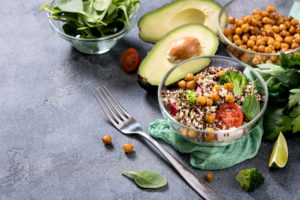During winter, our nutritional needs change and people generally become less physically active.
After all, when it’s cold, rainy and snowy outside, even a trip to a supermarket or grocery store is a daunting task. And with the advent of cold and flu season, staying healthy takes a bit more effort. What’s more, nutrition-packed fruits and vegetables that were plentiful during the summer may be in short supply—and take a bigger chunk out of our wallets.
However, there are many delicious and affordable ways to ensure proper nutrition for your winter diet. These tips will help you maintain optimum health and please your palate at the same time.
Free Download: 6 Risks of a Sedentary LifestyleHow to Boost Your Winter Diet and Nutrition
By adding these good-tasting and nutritious foods below to your winter diet, you can ensure that you and your family will weather the chilly season.
1. Go for Beans
There are many varieties of legumes, including garbanzo beans (aka chickpeas), lentils, lima beans, and pinto beans.
These hearty foods have something in common: they are fiber and protein powerhouses. Beans can be added to stews and soups, served in salads, and cooked and eaten by themselves. To reduce gassiness, soak them in water for six to eight hours and rinse before preparing.
2. Try Some Spuds
Potatoes have an undeserved bad reputation for their starch content. However, they are chock full of vital nutrients.
One potato provides hefty amounts of immunity-boosting vitamins B6 and C (29% and 25% of the recommended daily allowance of each). It also provides fiber(4 grams in an average-size potato). Addiotnally, potatoes contain folate, essential for the proper development of unborn babies. Purple potatoes are great sources of anthocyanins, antioxidants with a variety of benefits ranging from keeping heart disease at bay to reducing inflammation.
Adding carrots, parsnips, turnips, and other roots vegetables to mashed potatoes is a delicious way to include vegetables in your winter diet.
3. Talk Turkey
This bird is only not for Thanksgiving and Christmas. Low in calories and high in protein, it’s a natural winner in sandwiches, soup, salads, stir-fry, and by itself.
4. Include Winter Squash
Spaghetti, acorn, and butternut are only a few types of this colorful, tasty, nutritious vegetable.
Winter squash is low-calorie and rich in fiber, vitamin A, folic acid, and vitamin C. Acorn squash also has 30% of the RDA of vitamin B1, 25% of B6, and 31% of magnesium. And butternut squash is a powerhouse of vitamins A and C: 179% and 31% of their respective daily requirements. Leave off the butter and syrup and try a little margarine, applesauce, maple syrup, brown sugar, or cinnamon.
5. Add Some Greens and Reds
Chard, collards, and kale flourish in winter, In fact, frosty weather can reduce kale’s bitter taste.
With healthy amounts of vitamins C, A, and K—and plenty of folate in escarole, mustard greens, and collards—leafy greens can keep people’s immune systems in good shape. Red cabbage, a cousin of kale, contains few calories and lots of vitamin A. It also has zeaxanthin and lutein, phytochemicals which are important for eye health as people age.
6. Don’t Forget Fruit
Citrus fruit is loaded with vitamin C. Grapefruit, oranges, and their cousins are also excellent sources of all-important flavonoids. Hesperidin, the dominant flavonoid in citrus fruit, is known to raise HDL cholesterol (the good kind), reduce LDL cholesterol, and lower triglyceride levels.
And if you haven’t tried pomegranate juice, you may want to add it to your daily regimen. It contains more antioxidants than any other kind. Studies show that pomegranate juice may help prevent free radicals from doing damage and increase the flow of blood to the heart in patients whose tickers do not receive sufficient oxygen because of blocked arteries.
The Risks of a Sedentary Lifestyle
It’s probably not coming as any big news flash to you that smart nutrition and exercise combine for an unbeatable system of health, vitality and wellness in both mind and body, from head to toe. Besides, if you live to be 70 or 80, but the last 40 years of your life are plagued by health problems because you decided you would rather sit and lounge your way through life rather than being active, is that really living?
Check out these 6 serious health risks directly related to a sedentary lifestyle and you might just have enough motivation to move more and improve your diet.



